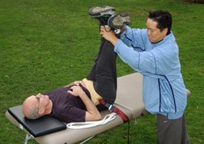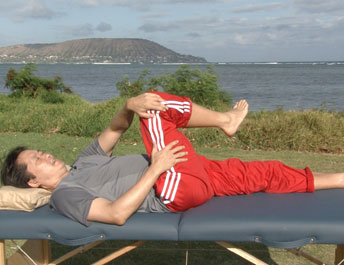Honolulu, Hawaii – Active Isolated Stretching developed by Kinesiologist Aaron Mattes changes the approach of muscle lengthening and thereby increases the effectiveness of physical pain resolution. It is the method of stretching that is ineffective, not the process of stretching. With a different approach, people can heal themselves from chronic pain problems. Aaron Mattes, of Sarasota, Florida, has been resolving people’s pain problems for over forty years. The Mattes Method approach is Musculo-Skeletal treatment, and is unlike any other physical pain treatment available in Honolulu, Hawaii. Mattes Method resolves commonplace physical pain problems, including back, neck, shoulder, jaw, knee, ankle, and foot pain that afflict thousands of Hawaii residents.
Why AIS is important?
 Why is it that so many Americans are suffering from back, neck, or shoulder pain? Aaron Mattes says that muscular shortening is a major contributer of physical pain problems. Muscles (and connective tissue, called fascia) affect the integrity of the skeletal frame. When muscles are shortened, a tensional imbalance is created around a joint (could be the back, neck, shoulder, wrist, knee. etc), which causes pain. Through the guidance of a Mattes trained therapist, the exact muscles causing dysfunction are lengthened, leading towards a resolution of physical pain.
Why is it that so many Americans are suffering from back, neck, or shoulder pain? Aaron Mattes says that muscular shortening is a major contributer of physical pain problems. Muscles (and connective tissue, called fascia) affect the integrity of the skeletal frame. When muscles are shortened, a tensional imbalance is created around a joint (could be the back, neck, shoulder, wrist, knee. etc), which causes pain. Through the guidance of a Mattes trained therapist, the exact muscles causing dysfunction are lengthened, leading towards a resolution of physical pain.
Muscles in the human body contain two attachments – two endpoints where the muscle is suspended. Within these two endpoints, muscles have a middle. inner, and outer anchoring. Considering both endpoints (attachments) means that a muscle has six aspects of attachment. Conventional stretching techniques only emphasize stretching at one point of attachment, the belly – the medial aspect of the proximal attachment. If only the belly of the muscle is stretched, five other aspects of the muscle go unattended, causing the muscle to quickly close down on itself. Mattes Method addresses stretching by lengthening both distal and proximal ends of the muscle, at medial and lateral attachments, allowing the target muscle to stay open and thereby encouraging the body to function without pain.





